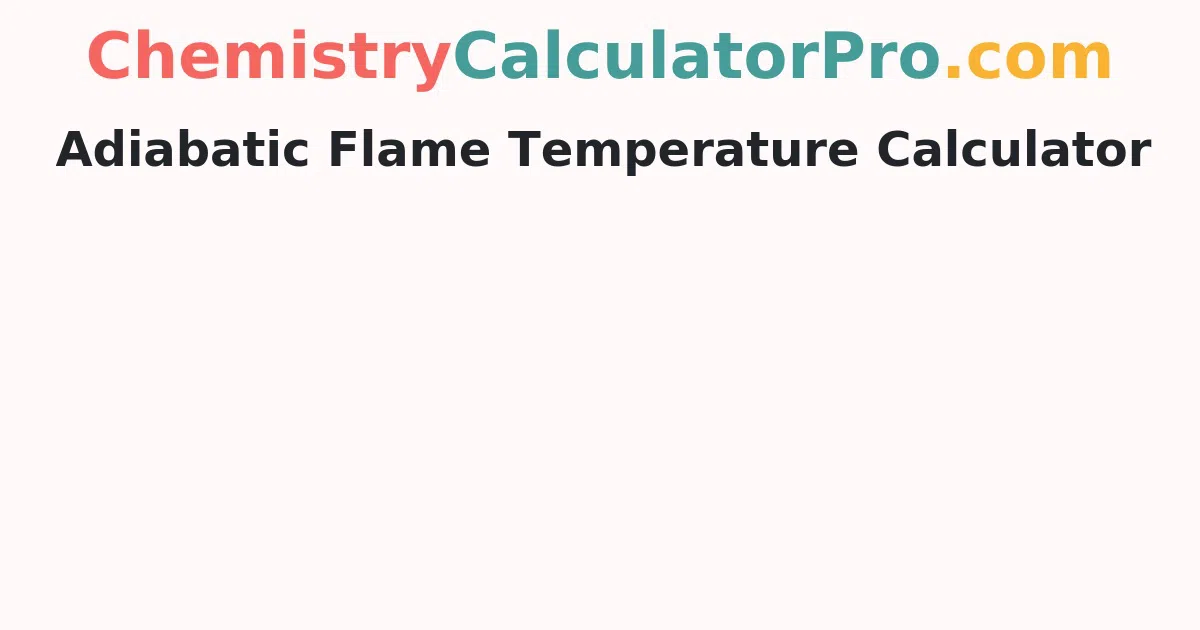Adiabatic Flame Temperature Calculator
Have you ever felt finding the Adiabatic Temperature is difficult? If so, don't bother anymore as we have a handy online Tool Adiabatic Flame Temperature Calculator. You can get the Adiabatic Flame Temperature of the combustion products in the blink of an eye on entering the inputs.
What is Adiabatic Flame Temperature?
Whenever a combustion reaction occurs eneregy is released to the combustion products. If at all there is no heat loss in the process the temperature of combustion products is known as Adiabatic Flame Temperature.
Adiabatic Flame Temperature of Various Products in Kelvin
| Fuel | Adiabatic Flame Temperature (K) |
|
|---|---|---|
| Oxygen *) as Oxidizer |
Air as Oxidizer |
|
| Acetaldehyde | 3817 | 2228 |
| Acetone | 3705 | 2253 |
| Benzene - C6H6 3) | 3784 | 2363 |
| Acetylene - C2H24) | 3997 | 2607 |
| n-Butane - C4H10 1) | 3867 | 2248 |
| Butylene - C4H8 2) | 3867 | 2494 |
| iso-Butane - C4H10 1) | 3861 | 2246 |
| Carbin disulfide | 2257 | |
| Cyclohexane | 3865 | 2250 |
| Cyanogen | 4855 | 2596 |
| Cyclopropane | 3904 | 2370 |
| Decane | 3833 | 2286 |
| Ethanol | 3730 | 2238 |
| Ethane - C2H6 1) | 3903 | 2222 |
| Ethylene - C2H4 2) | 3932 | 2375 |
| Hexane | 3855 | 2238 |
| Methane - CH4 1) | 3953 | 2236 |
| Hydrogen - H2 | 3473 | 2483 |
| Methanol | 3656 | 2222 |
| Neopentane - C5H12 1) | 3850 | 2511 |
| Naphthalene - C6H14 4) | 3943 | 2533 |
| n-Hexane - C10H8 1) | 3682 | 2494 |
| Neohexane - C6H14 1) | 3838 | 2508 |
| n-Heptane - C7H16 1) | 3851 | 2469 |
| Oxirane | 3796 | 2177 |
| iso-Pentane - C5H12 1) | 3857 | 2508 |
| n-Pentane -C5H12 1) | 3848 | 2505 |
| n-Pentene - C5H10 2) | 3865 | 2569 |
| Propane - C3H8 1) | 2526 | 2250 |
| Propylene- C3H6 2) | 3902 | 2528 |
| Toluene - C7H8 3) | 3786 | 2344 |
| p-Xylene - C8H10 3) | 3788 | 2483 |
| Triptane - C7H16 1) | 3836 | 2497 |
Types of Adiabatic Flame Temperature
In general, there are two types of Adiabatic Flame Temperature and they are namely
- Constant Pressure Adiabatic Flame Temperature
- Constant Volume Adiabatic Flame Temperature
Constant Pressure Adiabatic Flame Temperature:
As per the first law of thermodynamics at constant pressure ∆U = Qρ- Wp = Qρ - ρ∆V
H = U+ρ∆V
At constant pressure ∆H = ∆U+ρ∆V+V∆ρ =∆U+ρ∆V
In case of Adiabtic Conditions Qρ = 0, ∆H =0
In Equilibrium Reaction HReactants = HProducts
We know ΣHProducts(Ti,ρ) = Σni[∆H0f,i+Ai(T-TR)+Bi/2(T-TR)2+Ci/3(T-TR)2]
Flame Temperature can be determined considering the above equation. We will assume QVL =0. If we use the mean heat data capacity we have ΣHProducts(Ti,ρ) = Σni[∆H0f,i + (C¯ρ,l)(Tad-TRef)
Constant Volume Adiabatic Flame Temperature
As per the first law of thermodynamics QV = ∆U, QP-nRT = ∆HP-∆nRT
In case of adibatic process QV = 0 = ∆HP-nRT
HReactants(Ti, ρi) - HProducts(Tad, ρf)-R(nreactantsTi - nProductsTad) = 0
To know more about similar kind of calculators you can check our portal Chemistrycalculatorpro.com and make your calculations quick and simple.
FAQs on Free Adiabatic Flame Temperature Calculator
1. What affects Adiabatic Flame Temperature?
The Primary factors that influence the Adiabatic Flame Temperature are Fuel Air Ratio, Initial Temperature, Pressure and Fuel Type.
2. Does Adiabatic Flame Temperature increase with pressure?
At high pressures Adiabatic Flame Temperatures usually decrease instead of increasing as high pressure in the combustion chamber creates a back pressure.
3. How to find the Adiabatic Flame Temperature at constant volume?
At Constant Volume Adiabatic Flame Temperature can be found by equating internal energy of products and reactants.
4. Which gas has the highest Adiabatic Flame Temperature?
Zirconium has the highest Adiabatic Flame Temperature.
